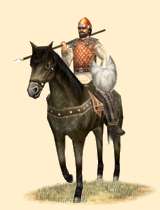Asiatikoi Hippeis (Medium Eastern Cavalry)
 |
Weapons | Defence | Mental | ||||||
|---|---|---|---|---|---|---|---|---|---|
| Primary | Secondary | Armour: | 8 | Morale: | 10 | ||||
| Type: | spear | axe | Shield: | 2 | Discipline: | impetuous | |||
| Attack: | 8 | 7 | Skill: | 8 | Training: | trained | |||
| Charge: | 27 | 15 | Recruitment | Other | |||||
| Lethality: | 0.15 | 0.165 | Soldiers: | 25 | Hit Points: | 1 | |||
| Range: | 0 | 0 | Cost: | 2176 | Mass: | 1 | |||
| Ammo: | 0 | 0 | Upkeep: | 544 | |||||
| Turns: | 1 | ||||||||

These medium cavalry represent a versatile task-force well able to perform a wide range of roles in battle.
Impetuous
These medium cavalry represent a versatile task-force well able to perform a wide range of roles in battle. They are excellent screeners well-suited to guard the flanks of a battle-line, well able to cut lighty armed horsemen to ribbons, as well as their qualities in pursuit. Such qualities would make them a worthwhile addition to any commander. They are armed with a thrusting spear, which they bear in an overhanded manner, and a vicious axe with a back-spike allowing them several advantages in melee. As such they are also suited for flanking and supportive roles. Still however, they are not well-suited to take on heavier cavalry or elite infantry formations, and their loyalty is only marked by the measured weight of gold.
Historically, these horsemen were prevalent around Asia Minor, the Near East, and further eastwards, marking them as an ethnically diverse contingent consisting of "Eastern" peoples, including Medeans, Persians, Albanians, Iberians, Armenians, Cappadocians and Syrians willing to fight for any wealthy master in exchange for whatever that may feed their horses and themselves for a longer term. As such, their equipment and clothing would also have differed, though not always were such horsemen drastically diverse in ethnical disposition. Comparatively they may be seen as a heavier variation of Pantodapoi horsemen.